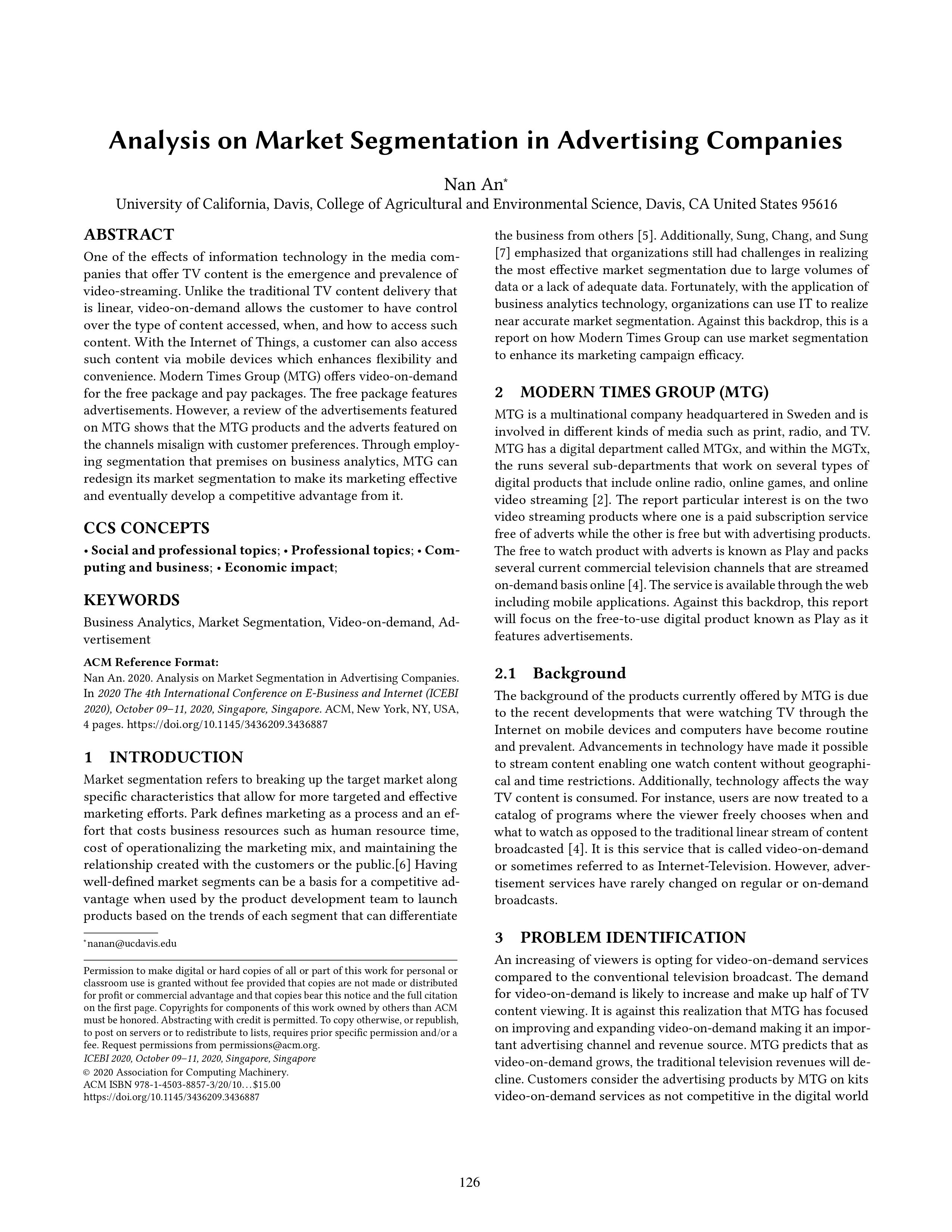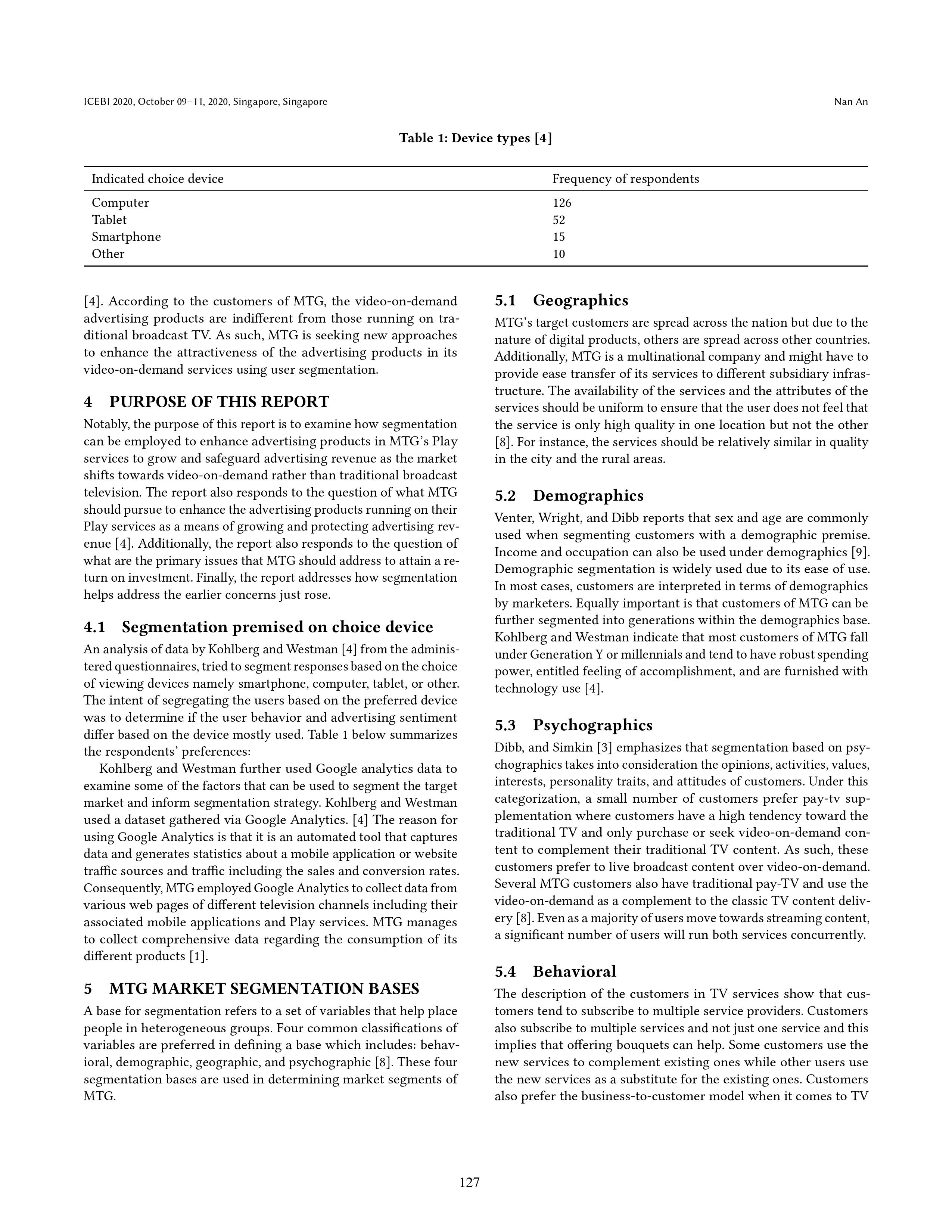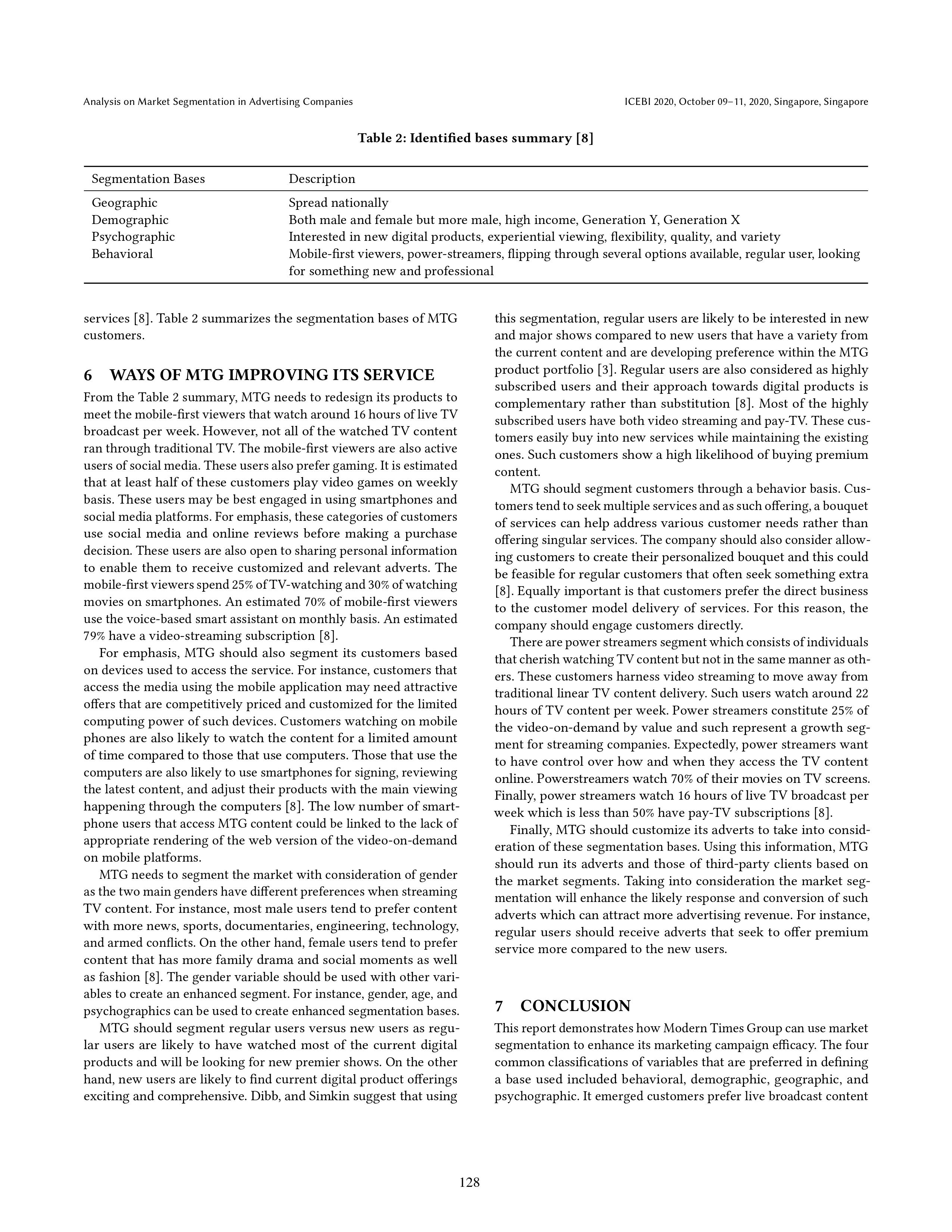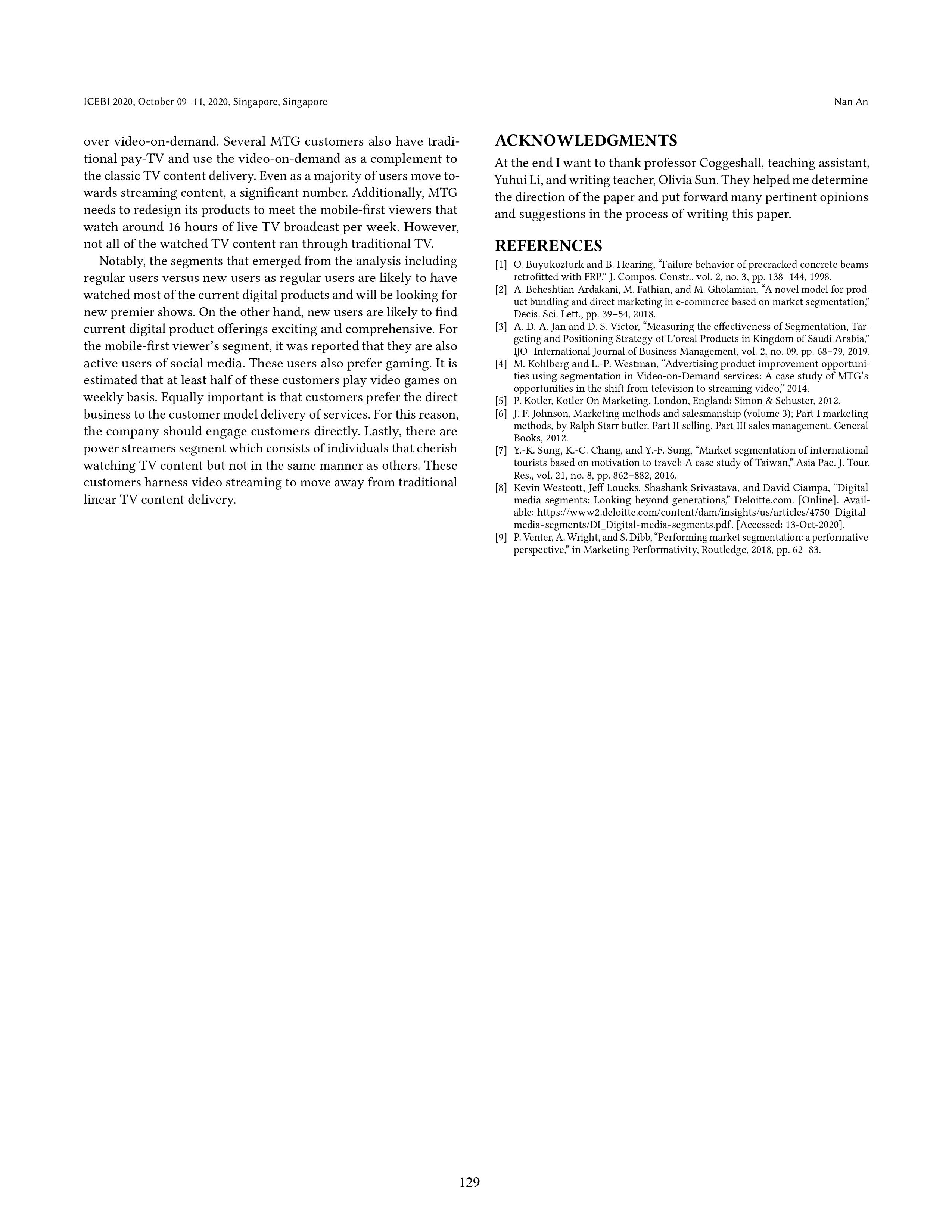Could you please give your review analysis on this article...just your insights on what can you say on this article...
Analysis on Market Segmentation in Advertising Companies Nan An* University of California, Davis, College of Agricultural and Environmental Science, Davis, CA United States 95616 ABSTRACT One of the elfects of information technology in the media com- panies that offer TV content is the emergence and prevalence of videostreaming. Unlike the traditional TV content delivery that is linear, video-on-demand allows the customer to have control over the type of content accessed, when, and how to access such content. With the Internet of Things, a customer can also access such content via mobile devices which enhances exibility and convenience Modern Times Group (MTG) offers Videoondemand for the free package and pay packages. The free package features advertisements. However, a review of the advertisements featured on MTG shows that the MTG products and the adverts featured on the channels misalign With customer preferences. Through employ ing segmentation that premises on business analytics, MTG can redesign its market segmentation to make its marketing effective and eventually develop a competitive advantage from it. CCS CONCEPTS o Social and professional topics; . Professional topics; . Com- puting and business; . Economic impact; KEYWORDS Business Analytics, Market Segmentation, Video-on-demand, Ad- vertisement ACM Reference Format: Nan An. 2020. Analysis on Market Segmentation in Advertising Companies. In 2020 The 4th International Conference on EBusiness and Internet (ICEBI 2020), October 0911, 2020, Singapore, Singapore. ACM, New York, NY, USA, 4 pages, httpS://doi.org/10.1 145/34362093436887 1 INTRODUCTION Market segmentation refers to breaking up the target market along specic characteristics that allow for more targeted and eifective marketing efforts. Park denes marketing as a process and an ef- fort that eosts business resources such as human resource time, cost of operationalizing the marketing mix, and maintaining the relationship created with the customers or the public.[6] Having well-dened market segments can be a basis for a competitive ad- vantage when used by the product development team to launch products based on the trends of each segment that can differentiate 'nanan(a)ucdavis.edu Permission to make digital or hard copies of all or part of this work for personal or classroom use is granted without fee provided that copies are not made or distributed for prot or commercial advantage and that copies bear this notice and the full citation on the rst page. Copyrights for components of this work owned by others than ACM must be honored. Abstracting With credit is permitted. To copy otherwise, or republish, to post on servers or to redistribute to lists, requires prior specic permission and/or a fee. Request permissions from permissions@acm.org. ICEBIZOZO, October 0911, 2020, Singapore, Singapore 2020 Association for Computing Machinery. ACM ISBN 97871745037885773/20/10. . .$15.00 https://d0i,org/10.]145/34362093436887 126 the business from others [5]. Additionally, Sung, Chang, and Sung [7] emphasized that organizations still had challenges in realizing the most effective market segmentation due to large volumes of data or a lack of adequate data. Fortunately, with the application of business analytics technology, organizations can use IT to realize near accurate market segmentation. Against this backdrop, this is a report on how Modern Times Group can use market segmentation to enhance its marketing campaign eicacy. 2 MODERN TIMES GROUP (MTG) MTG is a multinational company headquartered in Sweden and is involved in different kinds of media such as print, radio, and TV. MTG has a digital department called MTGx, and within the MGTx, the runs several sub-departments that work on several types of digital products that include online radio, online games, and online Video streaming [2]. The report particular interest is on the two Video streaming products where one is a paid subscription service free of adverts while the other is free but with advertising products. The free to watch product with adverts is known as Play and packs several current commercial television channels that are streamed onedemand basis online [4]. The service is available through the web including mobile applications. Against this backdrop, this report Will focus on the free-to-use digital product known as Play as it features advertisements. 2.1 Background The background of the products currently offered by MTG is due to the recent developments that were watching TV through the Internet on mobile devices and computers have become routine and prevalent. Advancements in technology have made it possible to stream content enabling one watch content Without geographi cal and time restrictions. Additionally, technology affects the way TV content is consumed. For instance, users are now treated to a catalog of programs where the viewer freely chooses when and what to watch as opposed to the traditional linear stream of content broadcasted [4]. It is this service that is called Video-on-demand or sometimes referred to as Internet-Television. However, adver- tisement services have rarely changed on regular or ondemand broadcasts. 3 PROBLEM IDENTIFICATION An increasing of viewers is opting for videoondemand services compared to the conventional television broadcast. The demand for video-on-demand is likely to increase and make up half of TV content viewing. It is against this realization that MTG has focused on improving and expanding video~onedemand making it an impor tant advertising channel and revenue source. MTG predicts that as Videoondemand grows, the traditional television revenues will de cline. Customers consider the advertising products by MTG on kits Video-ondemand services as not competitive in the digital world ICEBI 2020, October 09] 1, 2020, Singapore, Singapore Nan An Table 1: Device types [4] Indicated choice device Frequency of respondents Computer Tablet Smartphone Other [4]. According to the customers of MTG, the Video-on-demand advertising products are indifferent from those running on tra- ditional broadcast TV. As such, MTG is seeking new approaches to enhance the attractiveness of the advertising products in its video-ondemand services using user segmentation. 4 PURPOSE OF THIS REPORT Notably, the purpose of this report is to examine how segmentation can be employed to enhance advertising products in MTG's Play services to grow and safeguard advertising revenue as the market shifts towards Videoon-demand rather than traditional broadcast television. The report also responds to the question of what MTG should pursue to enhance the advertising products running on their Play services as a means of growing and protecting advertising rev enue [4]. Additionally, the report also responds to the question of what are the primary issues that MTG should address to attain a re4 turn on investment. Finally, the report addresses how segmentation helps address the earlier concerns just rose. 4.1 Segmentation premised on choice device An analysis of data by Kohlberg and Westman [4] from the adminis4 tered questionnaires, tried to segment responses based on the choice of viewing devices namely smartphone, computer, tablet, or other. The intent of segregating the users based on the preferred device was to determine if the user behavior and advertising sentiment differ based on the device mostly used. Table 1 below summarizes the respondents' preferences: Kohlberg and Westman further used Google analytics data to examine some of the factors that can be used to segment the target market and inform segmentation strategy. Kohlberg and Westman used a dataset gathered via Google Analytics. [4] The reason for using Google Analytics is that it is an automated tool that captures data and generates statistics about a mobile application or website trafc sources and trafc including the sales and conversion rates. Consequently, MTG employed Google Analytics to collect data from various web pages of different television channels including their associated mobile applications and Play services. MTG manages to collect comprehensive data regarding the consumption of its different products [1]. 5 MTG MARKET SEGMENTATION BASES A base for segmentation refers to a set of variables that help place people in heterogeneous groups. Four common classications of variables are preferred in dening a base which includes: behav ioral, demographic, geographic, and psychographic [8]. These four segmentation bases are used in determining market segments of MTG. 127 126 52 15 10 5. 1 Geographies MTG's target customers are spread across the nation but due to the nature of digital products, others are spread across other countries. Additionally, MTG is a multinational company and might have to provide ease transfer of its services to different subsidiary infras- tructure. The availability of the services and the attributes of the services should be uniform to ensure that the user does not feel that the service is only high quality in one location but not the other [8]. For instance, the services should be relatively similar in quality in the city and the rural areas. 5.2 Demographics Venter, Wright, and Dibb reports that sex and age are commonly used when segmenting customers with a demographic premise. Income and occupation can also be used under demographics [9]. Demographic segmentation is widely used due to its case of use. In most cases, customers are interpreted in terms of demographics by marketers. Equally important is that customers of MTG can be further segmented into generations within the demographics base. Kohlberg and Westman indicate that most customers of MTG fall under Generation Y or millennials and tend to have robust spending power, entitled feeling of accomplishment, and are furnished with technology use [4]. 5.3 Psychographics Dibb, and Simkin [3] emphasizes that segmentation based on psy chographics takes into consideration the opinions, activities, values, interests, personality traits, and attitudes of customers. Under this categorization, a small number of customers prefer paytv sup plementation where customers have a high tendency toward the traditional TV and only purchase or seek video-on-demand con- tent to complement their traditional TV content. As such, these customers prefer to live broadcast content over videoeonedemand. Several MTG customers also have traditional payTV and use the videoondemand as a complement to the classic TV content deliv- ery [8]. Even as a majority of users move towards streaming content, a signicant number of users will run both services concurrently. 5.4 Behavioral The description of the customers in TV services show that cus- tomers tend to subscribe to multiple service providers. Customers also subscribe to multiple services and not just one service and this implies that offering bouquets can help. Some customers use the new services to complement existing ones while other users use the new services as a substitute for the existing ones. Customers also prefer the business-to-customer model when it comes to TV Analysis on Market Segmentation in Advertising Companies lCEB] 2020, October 0911, 2020, Singapore, Singapore Table 2: Identied bases summary [8] Segmentation Bases Description Geographic Spread nationally Demographic Both male and female but more male, high income, Generation Y, Generation X Psychographic Interested in new digital products, experiential viewing, exibility, quality, and variety Behavioral Mobile-rst viewers, powerstreamers, ipping through several options available, regular user, looking for something new and professional services [8]. Table 2 summarizes the segmentation bases of MTG customers. 6 WAYS OF MTG IMPROVING ITS SERVICE From the Table 2 summary, MTG needs to redesign its products to meet the mobilerst viewers that watch around 16 hours of live TV broadcast per week. However, not all of the watched TV content ran through traditional TV. The mobileerst viewers are also active users of social media, These users also prefer gaming. It is estimated that at least half of these customers play Video games on weekly basis. These users may be best engaged in using smartphones and social media platforms. For emphasis, these categories of customers use social media and online reviews before making a purchase decision. These users are also open to sharing personal information to enable them to receive customized and relevant adverts. The mobilerst viewers spend 25% of TVwatching and 30% of watching movies on smartphones. An estimated 70% of mobilerst viewers use the voicebased smart assistant on monthly basis. An estimated 79% have a video-streaming subscription [8]. For emphasis, MTG should also segment its customers based on devices used to access the service. For instance, customers that access the media using the mobile application may need attractive offers that are competitively priced and customized for the limited computing power of such devices. Customers watching on mobile phones are also likely to watch the content for a limited amount of time compared to those that use computers. Those that use the computers are also likely to use smartphones for signing, reviewing the latest content, and adjust their products with the main viewing happening through the computers [8]. The low number of smart- phone users that access MTG content could be linked to the lack of appropriate rendering of the web version of the video-on-demand on mobile platforms. MTG needs to segment the market with consideration of gender as the two main genders have different preferences when streaming TV content. For instance, most male users tend to prefer content with more news, sports, documentaries, engineering, technology, and armed conicts. On the other hand, female users tend to prefer content that has more family drama and social moments as well as fashion [8]. The gender variable should be used with other vari ables to create an enhanced segment. For instance, gender, age, and psychographics can be used to create enhanced segmentation bases. MTG should segment regular users versus new users as regu lar users are likely to have watched most of the current digital products and will be looking for new premier shows. On the other hand, new users are likely to nd current digital product offerings exciting and comprehensive. Dibb, and Simkin suggest that using 128 this segmentation, regular users are likely to be interested in new and major shows compared to new users that have a variety from the current content and are developing preference within the MTG product portfolio [3]. Regular users are also considered as highly subscribed users and their approach towards digital products is complementary rather than substitution [8]. Most of the highly subscribed users have both video streaming and payTV. These cus tomers easily buy into new services while maintaining the existing ones. Such customers show a high likelihood of buying premium content. MTG should segment customers through a behavior basis. CusA tomers tend to seek multiple services and as such offering, a bouquet of services can help address various customer needs rather than offering singular services. The company should also consider allow ing customers to create their personalized bouquet and this could be feasible for regular customers that often seek something extra [8]. Equally important is that customers prefer the direct business to the customer model delivery of services. For this reason, the company should engage customers directly. There are power streamers segment which consists of individuals that cherish watching TV content but not in the same manner as oth ers. These customers harness Video streaming to move away from traditional linear TV content delivery. Such users watch around 22 hours of TV content per week. Power streamers constitute 25% of the video-on-demand by value and such represent a growth seg- ment for streaming companies. Expectedly, power streamers want to have control over how and when they access the TV content online. Powerstreamers watch 70% of their movies on TV screens. Finally, power streamers watch 16 hours of live TV broadcast per week which is less than 50% have payTV subscriptions [8]. Finally, MTG should customize its adverts to take into consid- eration of these segmentation bases. Using this information, MTG should run its adverts and those of third-party clients based on the market segments. Taking into consideration the market seg- mentation will enhance the likely response and conversion of such adverts which can attract more advertising revenue. For instance, regular users should receive adverts that seek to offer premium service more compared to the new users. 7 CONCLUSION This report demonstrates how Modern Times Group can use market segmentation to enhance its marketing campaign efcacy The four common classications of variables that are preferred in dening a base used included behavioral, demographic, geographic, and psychographic. It emerged customers prefer live broadcast content ICEBI 2020, October 09-11, 2020, Singapore, Singapore Nan An over video-on-demand. Several MTG customers also have tradi ACKNOWLEDGMENTS tional pay-TV and use the video-on-demand as a complement to At the end I want to thank professor Coggeshall, teaching assistant, the classic TV content delivery. Even as a majority of users move to- Yuhui Li, and writing teacher, Olivia Sun. They helped me determine wards streaming content, a significant number. Additionally, MTG the direction of the paper and put forward many pertinent opinions needs to redesign its products to meet the mobile-first viewers that and suggestions in the process of writing this paper. watch around 16 hours of live TV broadcast per week. However, not all of the watched TV content ran through traditional TV. REFERENCES Notably, the segments that emerged from the analysis including [1] O. Buyukozturk and B. Hearing, "Failure behavior of precracked concrete beams regular users versus new users as regular users are likely to have retrofitted with FRP," J. Compos. Constrvol. 2, no. 3, pp. 138-144, 1998. watched most of the current digital products and will be looking for (2] A. Beheshtian-Ardakani, M. Fathian, and M. Gholamian, "A novel model for prod- uct bundling and direct marketing in e-commerce based on market segmentation, new premier shows. On the other hand, new users are likely to find Decis. Sci. Lett., pp. 39-54, 2018. current digital product offerings exciting and comprehensive. For [3] A. D. A. Jan and D. S. Victor, "Measuring the effectiveness of Segmentation, Tar- the mobile-first viewer's segment, it was reported that they are also geting and Positioning Strategy of L'oreal Products in Kingdom of Saudi Arabia," JO -International Journal of Business Management, vol. 2, no. 09, pp. 68-79, 2019. active users of social media. These users also prefer gaming. It is [4] M. Kohlberg and L.-P. Westman, "Advertising product improvement opportuni- estimated that at least half of these customers play video games on ties using segmentation in Video-on-Demand services: A case study of MTG's weekly basis. Equally important is that customers prefer the direct opportunities in the shift from television to streaming video," 2014. [5] P. Kotler, Kotler On Marketing. London, England: Simon & Schuster, 2012. business to the customer model delivery of services. For this reason, 6] J. F. Johnson, Marketing methods and salesmanship (volume 3); Part I marketing the company should engage customers directly. Lastly, there are methods, by Ralph Starr butler. Part II selling. Part III sales management. General Books, 2012. power streamers segment which consists of individuals that cherish [7] Y.-K. Sung, K.-C. Chang, and Y.-F. Sung, "Market segmentation of international watching TV content but not in the same manner as others. These tourists based on motivation to travel: A case study of Taiwan," Asia Pac. J. Tour. customers harness video streaming to move away from traditional Res., vol. 21, no. 8, pp. 862-882, 2016. [8] Kevin Westcott, Jeff Loucks, Shashank Srivastava, and David Ciampa, "Digital linear TV content delivery. media segments: Looking beyond generations," Deloitte.com. [Online]. Avail able: https://www2.deloitte.com/content/dam/insights/us/articles/4750_Digital media-segments/DI_Digital-media-segments.pdf. [Accessed: 13-Oct-2020]. [9] P. Venter, A. Wright, and S. Dibb, "Performing market segmentation: a performative perspective," in Marketing Performativity, Routledge, 2018, pp. 62-83. 129










